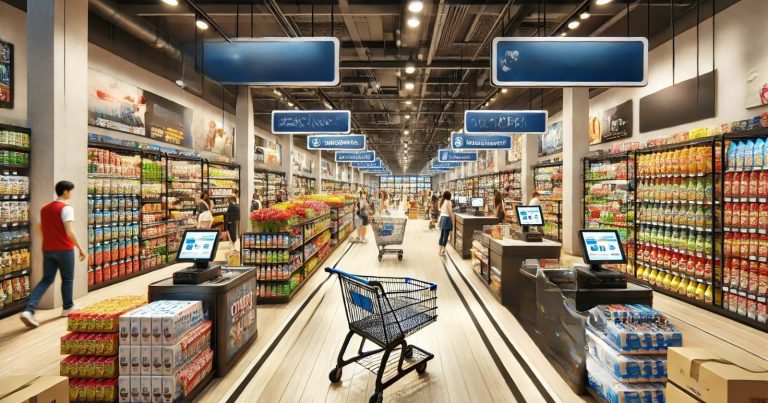A chain store is a chain of retail outlets owned and operated by the same organisation under the same brand. Such stores sell almost identical products under the same brand name and often follow a uniform business model. Chain stores come in many forms, including grocery, fashion, electronics, and fast food. The best examples of chain stores in India are Reliance Retail, Big Bazaar, DMart, and More Supermarket. These stores are convenient to the customers by offering standardised products, consistent pricing, and wide availability. Knowledge of the characteristics of chain stores aids in informed choice-making among businesses and consumers.
What is Chain Store?
A chain store is a series of retail outlets operating under one brand and owner. The firm has several units in various locations, which offers standardisation on price, range, and shop design. Chain stores function based on bulk purchases and centralised control, which improves cost-cutting and efficiency. Most retail chain stores work in the clothing (Zara, H&M), grocery (DMart, Reliance Fresh), and electronic (Croma, Vijay Sales) industries.
Features of Chain Store
A chain store has specific characteristics that distinguish it from other retail formats. Such features make chain stores successful in competitive markets. Such features of a chain store enable businesses to work efficiently and maintain close customer relationships.
- Uniform Product Offer: The same thing is sold in all branches, thereby maintaining quality and consistency. A consumer finds the same products in any branch, making shopping easy. This makes the consumer confident and gives constant value to shopping.
- Standardised Pricing: The price is standardised throughout all the locations. This ensures fairness. A central purchasing process will reduce the product cost compared to an independent store. A customer will not have to bother with differences in prices among locations.
- Centralised Control: Each outlet is managed by the parent company, through which uniform policies and branding are maintained. Headquarters decides on the issues of prices, advertisements, and stocks. This leads to an easy and streamlined business operation.
- Economies of Scale: Chain stores buy products in bulk, reducing procurement costs. Cost saving helps them to offer competitive prices. The lower cost helps increase profit margins and business growth.
- Strong Brand Identity: Chain stores retain a brand through uniform logos, advertisements, and layouts. Customers believe in well-known chain stores due to their consistency of quality. The more robust the brand image is, the more customers are attracted.
- Mass Marketing: Chain stores use television, digital, and print advertising to attract customers. Centralised promotion helps reach out to a wide audience. Mass marketing increases the visibility of a brand and subsequently increases sales.
- Customer Loyalty Programs: Reward and discount coupons for repeat shoppers are available from many chain stores. Membership increases retention and brand loyalty. Loyals will more likely return to the store, even refer to it.
Chain Stores Examples
Many large organisations use the chain store model to run several retail stores worldwide. These examples of chain stores in India and worldwide demonstrate how the model motivates business growth and customer happiness. Here are some of the popular chain store examples:
- Reliance Retail (India): Reliance Retail (India) is the largest chain store in India, under which there are groceries, electronics, and fashion. Reliance Fresh, Reliance Digital, and Trends are cost-effective products available to everyone across the country. So, with its wide network, shopping is easy for millions of customers.
- DMart (India): DMart is a popular retail chain store selling grocery and household products. DMart focuses on cost efficiency, bulk purchases, and everyday low pricing. Customers shop from DMart because it has more discounts and sells products at low prices.
- McDonald’s (International): McDonald’s is a fast food chain shop with thousands of outlets worldwide. It has standardised food quality, taste and price at all its outlets. Its quick service and familiar menu make it highly popular.
- Walmart (Global): One of the biggest retail chain stores worldwide, selling groceries, clothing, and electronics at reasonable costs. The company operates thousands of outlets under the same brand. Its large stores provide customers with everything they want in one outlet.
- Big Bazaar (India): Big Bazaar, part of the Reliance Retail chain, was big in India, offering grocery, clothing, and home essentials to people. It adopted the discount store format to attract middle-class spenders. They also became popular for their deals and promotions.
- Croma (India): Croma is one of India’s top chains, specialising in electronics and home appliances. One can expect the same prices and products everywhere. It would be customers’ reliance upon the quality of electronics and services they get from the professional team in any of the Croma.
Advantages and Disadvantages of Chain Store
Chain stores have benefits, but there are also disadvantages. Understanding these will help businesses and customers make the right choices. Despite the challenges, retail chain stores are a popular business model because of their reach and customer loyalty.
Advantages of Chain Store
Chain stores offer several benefits that make shopping easier and more affordable for customers. They have a strong brand presence, competitive pricing, and wide availability that attract more buyers and ensure a consistent shopping experience.
- Lower Prices: Bulk purchasing reduces the cost of buying through chain stores, which sell in smaller amounts to users. Customers get to save money from buying at chain stores. Stores offer frequent discounts to attract additional buyers.
- Brand recognition: Consumers prefer well-known brands because of quality consistency. Consumers feel safe to shop from recognized brands. When a store boasts a great brand image, consumers become loyal.
- Customer Convenience: There are many locations where one can easily find the products anywhere. Customers can shop from the nearest store without traveling for long distances. Chain stores also provide online shopping to make it more convenient.
- Uniform Quality and Service: Uniform quality and services ensure the satisfaction of customers. The customer experience is the same everywhere. There will be good service everywhere since people are well trained.
- Strong Advertisements and Promotions: Consolidated marketing campaigns attract more customers. Stores use TV, social media, and billboards to reach people. Special deals and festive sales bring in more shoppers.
Disadvantages of Chain Store
Chain stores have many advantages but also disadvantages. High costs, management difficulties, and competition with local businesses may hinder their growth and success.
- High Initial Investment: Opening up various outlets requires heavy capital investment. Companies require vast amounts of money to open and run stores. Small businesses are not in a position to compete with large chain stores.
- Limited Product Variety: Stores sell pre-selected items, thus limiting the customer’s choice. Customers will not find unique or locally made products. The same product selection in all stores feels repetitive.
- Difficult Management: Managing several locations is very challenging and requires extensive coordination and logistics. Store owners must track inventory, sales, and staff performance. Any mistake in one store can affect the entire business.
- Competition with Local Shops: Small shops cannot compete with the big chain stores. Due to low prices in chain stores, local shops lose customers. Many small shops close down as they cannot provide discounts like the big stores.
- Employee Dissatisfaction: Inflexible work policies may decrease employee’s desire and innovative thinking. The staff may feel burdened by extreme corporate policies. The lack of flexibility might contribute to lower job satisfaction and high turnover of employees.
Difference Between Department Store and Chain Store
Department and chain stores are very popular retail formats. However, they differ in operation. Understanding their key differences helps shoppers and businesses determine the right shopping experience.
| Feature | Department Store | Chain Store |
| Ownership | Single large store | Multiple outlets under one brand |
| Product Variety | Wide range of categories in one location | The same products in all outlets |
| Pricing | Higher prices due to premium services | Standardised pricing across locations |
| Management | Single store management | Centralised control from headquarters |
| Location | Large cities and commercial areas | Found in multiple locations nationwide |
| Example | Shoppers Stop | DMart, Reliance Retail |
Chain Store FAQs
1. What are some chain stores examples in India?
Some Popular chain stores include Reliance Retail, DMart, Croma, More supermarket, and Big Bazaar in Indi, with hundreds of Outlets under standard Pricing and Products.
2. What are the features of chain store?
Departmental management centralised pricing and standardized products, offering large-scale advertisements, multilateral retailers, and multiple retailers with various brands at the local shop. The outlet
3. What is the difference between department store and chain store?
A departmental store keeps all kinds of products under one roof, and a chain store has its outlets at several places selling identical products at the same prices.
4. What are the advantages and disadvantages of chain store?
Advantages are low prices, brand name, and comfort of the customer. The disadvantages are high investment, fewer varieties of products, and they compete with the small retailers.
5. How does a chain store operate?
Retail chain stores operate under a centralised management system where the parent company controls pricing, inventory, marketing, and branding across multiple locations.


